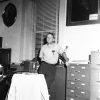calsfoundation@cals.org
When the Century Was Young
When the Century Was Young is a memoir by Dorris Alexander (Dee) Brown, author of more than twenty books, including the bestsellers Bury My Heart at Wounded Knee and Creek Mary’s Blood. The memoir, published by August House in 1993, offers illuminating stories of his life but is largely an engaging testimony of Brown’s love of the printed word, beginning at his youth, a time he calls the “golden age of print.”
The thirteen chapters are discrete stories about his life as a youth, student, apprentice printer and journalist, college scholar, army enlisted man, librarian, and author. Along the way, readers are introduced to the prime influences on Dee Brown’s life as a writer and student of the American West.
At age five, after the untimely death of Brown’s father, Daniel, his mother, Lula Cranford Brown, moved his family to Stephens (Ouachita County). There, his maternal grandmother, Ann Elizabeth Cranford, taught Brown how to read out of a first-grade primer. As he wrote, “To me, the event was the discovery of a hidden secret….It was the most startling event of my childhood.”
In 1924, the Browns moved to Little Rock (Pulaski County), mainly because his mother wanted Brown and his sister Corinne to “obtain good high school educations.” At Little Rock High School, a librarian pointed him toward the three-volume History of the Expedition under the Command of Captains Lewis & Clark, which profoundly influenced his future life as a writer about the American West.
Brown also learned how to use a Linotype machine at Little Rock High, and later became a printer and reporter at the Harrison Daily Times in Boone County before enrolling at Arkansas State Teachers College (now the University of Central Arkansas) in Conway (Faulkner County). At college, Brown met history professor Dean McBrien, a student of western American history. Of him, Brown wrote, “Dean McBrien more than any other mentor set me upon the course I was to take as a writer.”
After finishing his undergraduate degree, Brown moved to Washington DC to attend George Washington University during the Great Depression. He also worked in the Civilian Conservation Corps (CCC) and the U.S. Department of Agriculture library system, and, while in the U.S. Army during World War II, served as a librarian. During the time immediately after World War II, Brown joined with another librarian, Martin Schmitt, to co-author Fighting Indians of the West, Brown’s first nonfiction book.
The last chapters of When the Century Was Young are devoted to Brown’s time as the librarian of the College of Agriculture at the University of Illinois at Urbana-Champaign. The epilogue, however, includes the essence of what Brown expresses throughout the book, in which he paraphrases Thomas Carlyle, “The art of writing is the most miraculous of all things man has devised.”
For additional information:
“August House to Publish Brown Memoir.” Arkansas Democrat-Gazette, January 31, 1993, p. 8J.
Brown, Dee. When the Century Was Young. Little Rock: August House, 1993.
Trimble, Mike. “Memoir Recounts Love Affair with Printed Words on a Page.” Arkansas Democrat-Gazette, October 3, 1993, pp. 1J, 2J.
Jeff Waggoner
Nassau, New York
 Divergent Prosperity and the Arc of Reform, 1968–2022
Divergent Prosperity and the Arc of Reform, 1968–2022 Literature and Authors
Literature and Authors




Comments
No comments on this entry yet.